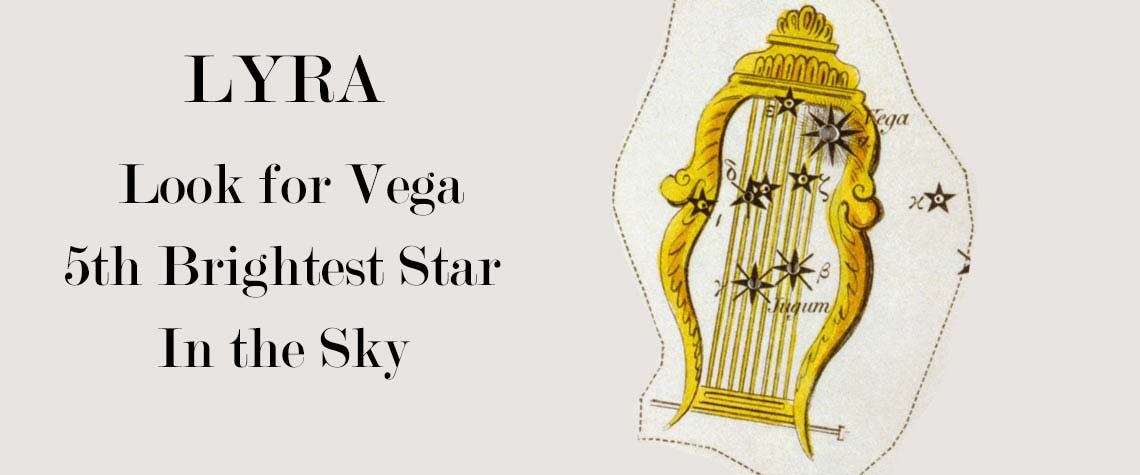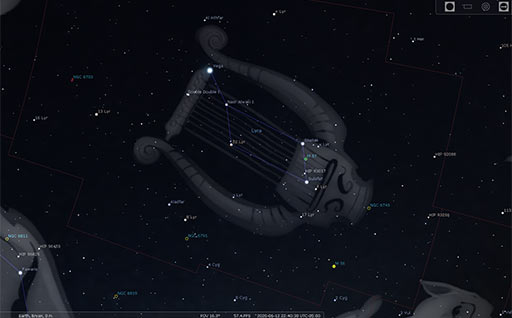Page 6


EYE ON THE SKY - Lyra
By Tom Campbell
In Roman mythology, the winged messenger Mercury was resting beside the Nile River one day and noticed an empty turtle shell. He picked it up and played with it and noticed that whenever he tapped it, the sound would echo inside. He fastened some strings to the shell and with his magic touch, he created a lyre which produced enchanting music. Mercury traded the lyre to Apollo in exchange for the caduceus staff and taught him to play it. Eventually Apollo gave this lyre to his son, Orpheus.
On the day of Orpheus' wedding to Eurydice, she stepped on a viper and was bitten and died instantly. His grief was inconsolable and he decided to go see Pluto (the god of the Underworld) and try to get her back. Orpheus played his lyre before Pluto and the music was so beautiful that it charmed Pluto and all the dead inhabitants of Hades. Pluto agreed to let Eurydice return with him to the living, on the condition they leave and never look back.
He agreed and the two lovers began their ascent back to Earth. As they approached the entrance, Orpheus glanced back to make sure Eurydice was still behind him and watched in horror as she was suddenly dragged back down into Hades forever.
Orpheus roamed the hills and woodlands, lost in grief and playing his lyre in sad but beautiful tones. The magical music charmed all the wildlife and even trees began following him along as he played. Any girl within earshot of his music was immediately attracted to Orpheus, but he rejected them all.
Angry, the rejected girls banded together and decided to murder Orpheus for all the heartbreak he caused them. They threw stones and arrows at him, but the music stopped them in midair and they fell harmlessly to the ground. Finally, the girls screamed in frustration and their screams became louder than the music from the lyre and the weapons found their mark. They stabbed Orpheus repeatedly and threw his lyre into the river.
Jupiter, seeing all this transpire, sent a vulture to swoop down and pull the lyre out of the river and he placed it in the heavens as a tribute to lost love.
Vega (α Lyr) is the fifth-brightest star in the night sky, and makes Lyra one of the easier constellations to find in the sky. Due to Earth's precession, Vega was our northern pole star 14,000 years ago and will be again in another 12,000 years. It was the first star other than the Sun to have its spectrum recorded and its brightness is the baseline for the current magnitude scale.
Vega has one of its poles facing Earth, and is spinning so fast at the equator (146 miles/sec), it would fly apart if it were a mere 12% faster. This speed makes the star bulge wider than it would normally be and appear brighter than it normally would.
In a telescope, Vega appears almost a blinding blue-white and in a reflecting telescope, the diffraction spikes make it resemble a Christmas Star.
Sheliak (β Lyr) is a multiple star system about 960 light years away. In a telescope, you can easily detect three of the members in a nearly-straight line. The brightest star is in the middle, and appears white. The second brightest member is blue-white. Nearby is a fourth, unrelated star that creates a nice triangle with the system.
In binoculars, δ1 Lyr and δ2 Lyr are easily separated into an orange and white pair. In the eyepiece of a telescope, however, three main stars form an almost perfect equilateral delta triangle, with a few other fainter stars scattered between. This group of stars, of which there are about 33 members, was first suspected to be a true cluster in 1959 by American astronomer Charles Stephenson. It has subsequently been catalogued as Stephenson 1.
The Double Double (ε Lyr) is one of the most famous multiple star systems in astronomy. Although there are at least five members of this system, the fifth can only be detected spectoscopically due to its nearness to its companion (it has a maximum separation of 0.2 arcseconds). In binoculars, it looks like a widely-separated double star of similar magnitude. At moderate magnification in a telescope, however, each of these stars can be split into two distinct stars, oriented perpendicularly to each other. All four components share similar magnitudes and spectral types.
Nasr Alwaki (ζ Lyr) is a wide double star that is easily split at low magnification. The primary is white and the slightly fainter secondary is a pale yellow. The brighter star has another spectroscopic companion that orbits the star every 4.3 days in an almost perfectly circular orbit.
λ Lyr is close to γ Lyr and is a beautiful red giant. Nearing the end of its short lifespan, this 58 million-year-old star (our Sun, by contrast, is about 5 billion years old) has exhausted its hydrogen and has expanded to approximately 102 times the radius of our own Sun. If you were to put λ Lyr where our Sun is, its surface would reach halfway between Mercury and Venus.
Messier 56 is a globular cluster located about 32,900 light years from Earth. It is actually travelling in a retrograde orbit about the Milky Way, suggesting that it was captured by a galactic merger with a dwarf galaxy. This galaxy has been dubbed the Gaia Sausage, and the globular cluster Omega Centauri is what survives of its nucleus. With my 12-inch, it was somewhat faint but large, and I was able to resolve some of the outermost stars on a night of moderate seeing conditions.
Messier 57 (Ring Nebula) is a planetary nebula, a ring of gas thrown off a dying star as it exhausts its fuel and begins to contract. In telescopes, the nebula appears as a wispy grey ring of smoke, but in larger amateur instruments, hints of green and red can sometimes be seen. The central star is a white dwarf that shines 200 times more luninous than our Sun, but due to its distance and the intervening gas and dust, it has an apparent magnitude of 15.7 and can only be seen in larger telescopes.
NGC 6791 is an open cluster believed to be about 8 billion years old. It is very metal-rich, which contradicts its old age, and thus has been one of the most studied open clusters in the sky. In my telescope, it appeared dim and a few foreground stars sprinkled on top of it added to the difficulty in discerning much detail.
Σ2470 and Σ2474 together make up The Other Double Double. Each of these are pairs of stars which are visible in the same field of view. Σ2470's primary component appears yellow and its companion is yellow-orange. For Σ2474, hwoever, the main star is blue-white and its secondary star is slightly yellowish. This makes for a more beautiful "Double Double" as well as being much easier to separate into its four components, than the original.
| Object | Type | Mag(s) | Dist. (ly) | R. A. | Dec. |
|---|---|---|---|---|---|
| Vega (α Lyr) | Star | 0.0 | 25 | 18h 36.9m | +38° 47' |
| Sheliak (β Lyr) | Multiple Star | 3.5, 7.2, 9.9 | 960 | 18h 50.1m | +33° 22' |
| δ Lyr | Open Cluster | 3.8 | 1,220 | 18h 53.5m | +36° 55' |
| Double Double (ε Lyr) | Multiple Star | 4.7, 6.2, 5.1, 5.5 | 160 | 18h 44.3m | +39° 40' |
| Nasr Alwaki (ζ Lyr) | Double Star | 4.4, 5.7 | 156 | 18h 44.8m | +37° 36' |
| λ Lyr | Red Giant | 4.9 | 1,300 | 19h 00.0m | +32° 09' |
| M56 | Globular Cluster | 8.3 | 32,900 | 19h 16.6m | +30° 11' |
| M57 (Ring Nebula) | Planetary Nebula | 8.8 | 2,570 | 18h 53.6m | +33° 02' |
| NGC 6791 | Open Cluster | 9.5 | 13,300 | 19h 20.9m | +37° 46' |
| Σ2470 | Double Star | 7.0, 8.4 | 41 | 19h 08.8m | +34° 46' |
| Σ2474 | Double Star | 6.8, 7.9 | 170 | 19h 09.1m | +34° 36' |
About the Author:
Tom Campbell is a software developer and NASA/JPL Solar System Ambassador who is frequently seen sharing his love of the universe with others.

Tom Campbell
Website: http://astro.tomandjul.com/
